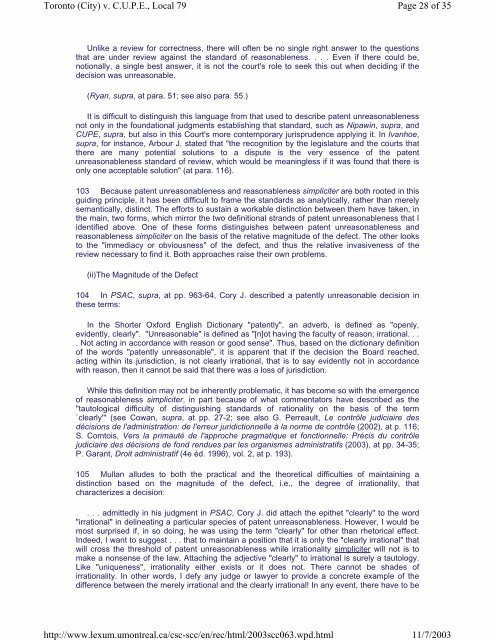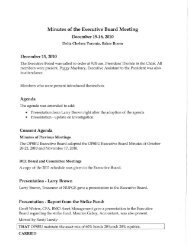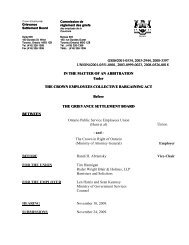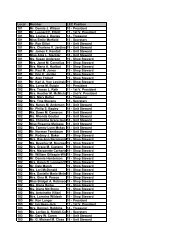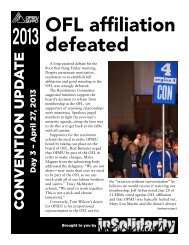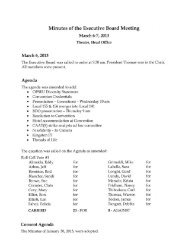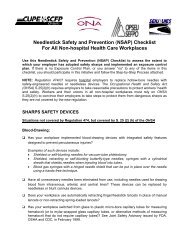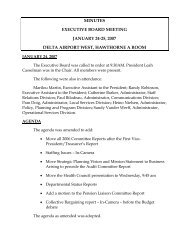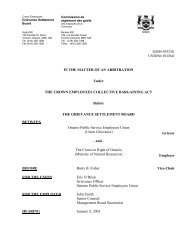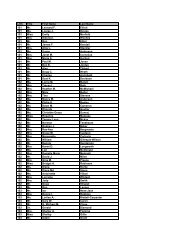C.U.P.E., Local 79 v. Toronto (City) .pdf - OPSEU
C.U.P.E., Local 79 v. Toronto (City) .pdf - OPSEU
C.U.P.E., Local 79 v. Toronto (City) .pdf - OPSEU
You also want an ePaper? Increase the reach of your titles
YUMPU automatically turns print PDFs into web optimized ePapers that Google loves.
<strong>Toronto</strong> (<strong>City</strong>) v. C.U.P.E., <strong>Local</strong> <strong>79</strong><br />
http://www.lexum.umontreal.ca/csc-scc/en/rec/html/2003scc063.wpd.html<br />
Page 28 of 35<br />
11/7/2003<br />
Unlike a review for correctness, there will often be no single right answer to the questions<br />
that are under review against the standard of reasonableness. . . . Even if there could be,<br />
notionally, a single best answer, it is not the court's role to seek this out when deciding if the<br />
decision was unreasonable.<br />
(Ryan, supra, at para. 51; see also para. 55.)<br />
It is difficult to distinguish this language from that used to describe patent unreasonableness<br />
not only in the foundational judgments establishing that standard, such as Nipawin, supra, and<br />
CUPE, supra, but also in this Court's more contemporary jurisprudence applying it. In Ivanhoe,<br />
supra, for instance, Arbour J. stated that "the recognition by the legislature and the courts that<br />
there are many potential solutions to a dispute is the very essence of the patent<br />
unreasonableness standard of review, which would be meaningless if it was found that there is<br />
only one acceptable solution" (at para. 116).<br />
103 Because patent unreasonableness and reasonableness simpliciter are both rooted in this<br />
guiding principle, it has been difficult to frame the standards as analytically, rather than merely<br />
semantically, distinct. The efforts to sustain a workable distinction between them have taken, in<br />
the main, two forms, which mirror the two definitional strands of patent unreasonableness that I<br />
identified above. One of these forms distinguishes between patent unreasonableness and<br />
reasonableness simpliciter on the basis of the relative magnitude of the defect. The other looks<br />
to the "immediacy or obviousness" of the defect, and thus the relative invasiveness of the<br />
review necessary to find it. Both approaches raise their own problems.<br />
(ii)The Magnitude of the Defect<br />
104 In PSAC, supra, at pp. 963-64, Cory J. described a patently unreasonable decision in<br />
these terms:<br />
In the Shorter Oxford English Dictionary "patently", an adverb, is defined as "openly,<br />
evidently, clearly". "Unreasonable" is defined as "[n]ot having the faculty of reason; irrational. . .<br />
. Not acting in accordance with reason or good sense". Thus, based on the dictionary definition<br />
of the words "patently unreasonable", it is apparent that if the decision the Board reached,<br />
acting within its jurisdiction, is not clearly irrational, that is to say evidently not in accordance<br />
with reason, then it cannot be said that there was a loss of jurisdiction.<br />
While this definition may not be inherently problematic, it has become so with the emergence<br />
of reasonableness simpliciter, in part because of what commentators have described as the<br />
"tautological difficulty of distinguishing standards of rationality on the basis of the term<br />
`clearly'" (see Cowan, supra, at pp. 27-2; see also G. Perreault, Le contrôle judiciaire des<br />
décisions de l'administration: de l'erreur juridictionnelle à la norme de contrôle (2002), at p. 116;<br />
S. Comtois, Vers la primauté de l'approche pragmatique et fonctionnelle: Précis du contrôle<br />
judiciaire des décisions de fond rendues par les organismes administratifs (2003), at pp. 34-35;<br />
P. Garant, Droit administratif (4e éd. 1996), vol. 2, at p. 193).<br />
105 Mullan alludes to both the practical and the theoretical difficulties of maintaining a<br />
distinction based on the magnitude of the defect, i.e., the degree of irrationality, that<br />
characterizes a decision:<br />
. . . admittedly in his judgment in PSAC, Cory J. did attach the epithet "clearly" to the word<br />
"irrational" in delineating a particular species of patent unreasonableness. However, I would be<br />
most surprised if, in so doing, he was using the term "clearly" for other than rhetorical effect.<br />
Indeed, I want to suggest . . . that to maintain a position that it is only the "clearly irrational" that<br />
will cross the threshold of patent unreasonableness while irrationality simpliciter will not is to<br />
make a nonsense of the law. Attaching the adjective "clearly" to irrational is surely a tautology.<br />
Like "uniqueness", irrationality either exists or it does not. There cannot be shades of<br />
irrationality. In other words, I defy any judge or lawyer to provide a concrete example of the<br />
difference between the merely irrational and the clearly irrational! In any event, there have to be


